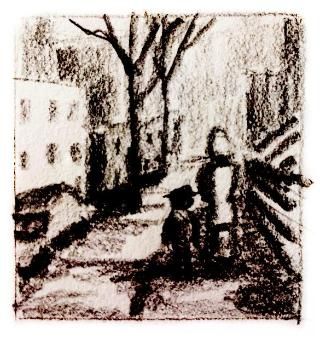Asher Lev Discussion Guide: Part 5

Chapters 13 and 14
Dr. David McNutt (Core Studies)
In the climax of the novel, Asher paints two versions of the Brooklyn Crucifixion, and he then displays them at an exhibit where his parents are present. The works are successes critically and financially, but they horrify Asher’s parents and his Jewish community. Both humbled and yet determined to pursue his artistic calling, Asher leaves for Paris.
- During his time in Florence, Asher is particularly moved by viewing Michelangelo’s Pietá and David. Asher says that his work was “an act of awesome rebellion against his tradition and his teacher” (312). Do you think Asher aspires to a similar rebellion?
- In his travels through Europe, Asher encounters not only great works of art, but also members of the Jewish Ladover community, all of whom know and revere his father, Aryeh, whose work is described as “creation out of nothing” (315). What is the relationship between God’s act of creation, Aryeh’s work, and Asher’s artistic work?
- Asher decides to paint two versions of Brooklyn Crucifixion because he thought that the first version was “incomplete” (327-8). What is your reaction to Asher’s decision to paint these two works?
- When Asher paints his mother crucified between himself and his father, he says that he chose to do so because “there was no aesthetic mold in his own religious tradition into which he could pour a painting of ultimate anguish and torment” (330). Do you agree?
- View an image of Chagall’s White Crucifixion. What do you notice?
- When he returns to Brooklyn, Asher encounters several familiar figures: his parents; Yudel Krinsky; his Uncle Yitzchok; Jacob Kahn. How have they changed? How has Asher changed?
- Asher tells Anna Schaeffer that he is concerned about showing the crucifixions at his show because they will “hurt people… people I love” (344). What is your reaction to Asher’s decision to show them anyways?
- When he views the paintings in the gallery, Asher prays to God for forgiveness because he “did not mean to attempt to emulate Your power, Your ability to create out of nothing” (357). Do you think Asher needs to ask for forgiveness? Why or why not?
- Asher’s mother tells him that “there are limits” to art (361), and the Rebbe says that Asher has “crossed a boundary” with the paintings of the crucifixions (367). Are there limits to art? If so, what are they?
- It seems that Asher chose between his art and his family in pursuing his artistic gift and in painting the crucifixions, which he knew would cause harm. Did he also choose between his art and his faith?
- Looking at his right hand, Asher reflects upon the power that it contains: “Art was demonic and divine” (367). Read Exodus 31:1-11, then read Exodus 32. Is artistic skill a blessing or a danger?
- How have your impressions of Asher changed over the course of reading the book?
- The title of the book appears many times throughout the novel as Asher often says, “My name is Asher Lev” (e.g., as a young artist in response to his uncle; the first time he met Jacob Kahn). At the end of the book, he identifies himself as “Asher Lev, Hasid. Asher Lev, painter.” (367) How would you describe Asher Lev?
- How does Asher’s story resonate with your own experience?
